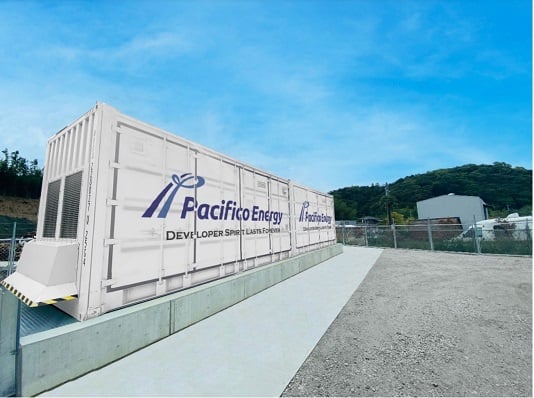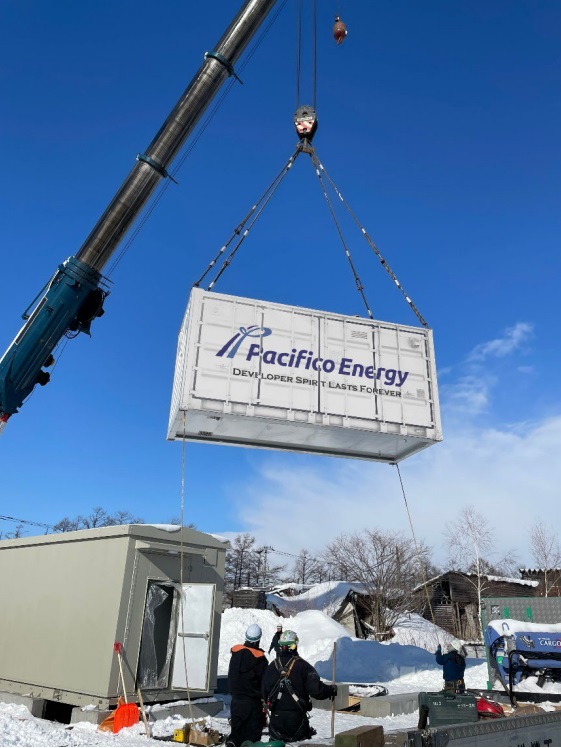
In June, Japanese renewable energy developer Pacifico Energy put in action the first trades from battery energy storage system (BESS) assets in the country’s power markets.
The two projects developed and brought online by Pacifico are each of 2MW output and 8MWh energy storage capacity, one sited on the northern island of Hokkaido, the other in the south in Fukuoka, on the island of Kyushu.
Enjoy 12 months of exclusive analysis
- Regular insight and analysis of the industry’s biggest developments
- In-depth interviews with the industry’s leading figures
- Annual digital subscription to the PV Tech Power journal
- Discounts on Solar Media’s portfolio of events, in-person and virtual
You can read about the basics of the project and their background, with a rapid construction timeline that began in September 2022, and how the developer is one among many to spot the opportunities at present and that lie ahead for batteries in Japan, in our news report from 27 June.
Below, we speak in further depth with Mahdi Behrangrad, head of energy storage at Pacifico Energy, for some details on key aspects of the projects, and what they might mean for the opening of the Japanese BESS market, which has been long awaited and appears to be warmly welcomed across the industry.
Behrangrad has been involved in the energy storage sector for close to 15 years, in a journey encompassing different parts of the energy storage, or “new energy” value chain with Japanese companies.
From manufacturing of lithium-ion batteries with Panasonic, to flow batteries with Sumitomo Electric, to creating the technology around aggregating fleets of distributed storage and advising stakeholders including utilities on strategies for adopting these “new energy” assets, Behrangrad brings a holistic perspective to the conversation.
Behrangrad joined Pacifico in 2021 to set up its energy storage division. Recognised already as one of the company’s three pillars of its strategy, alongside solar PV and offshore wind, his department quickly from there executed the two projects simultaneously to begin bidding in the market this June.
Specific to Japan
What are some of the key takeaways that you’ve really taken from other markets and things that can work in Japan? What are some of the things that you really had to tailor more to be specific for the Japanese case?
What we can learn about from other markets is: first of all, ensuring you have a top line supply chain, you have a safety and quality point of view to projects from the very early stages, even though you might not have local regulation around it.
For example, in Japanese local firefighting regulation, there’s still not a need to have automated fire detection and extinguishing system in a system in a container itself. It’s definitely it’s going to be a little bit of cost reduction, but from our perspective, this is not a local business.
In terms of safety and quality, we should go window shopping around the world and try to select the best, even though you’re not forced doing it locally.
Second is making sure we have best in class solutions in place, going beyond the borders, because I strongly believe this is a very international business. In our case, we have batteries from China, PCS is from Korea, and the aggregation system is from Japan. How you want to marry all these things together, under Japanese regulation is something that is challenging.
Third is that always we should have a look on the pure business side in terms of being able to finance it and scale it.
We don’t hunt for subsidies. Even the first time that we got a subsidy was to demonstrate our capability, that we can do the things in a tight timeline. It’s very critical that from early stage of the business, you have a business strategy that doesn’t rely on any subsidy, otherwise, your growth and your margin is always decided by something that you have no control over. It makes it very difficult to make a financeable project or a scalable project.
[Another thing is] having an international pool of talent and expertise, because Japan still needs some catch up in that sense.
4-hour duration
Energy-Storage.news: The battery storage systems at Shiroishi in Hokkaido and Itoshima in Kyushu are assets with relatively long duration, compared to what’s typically seen in less mature markets for grid-connected battery storage. Presumably this sizing decision came after considerable modelling and simulation, but what’s behind that decision?
The result comes from considering a mix of parameters. Number one the modelling of how you forecast the revenue will be in the long run of the project.
The second parameter is the market regulation. For example, in Japan for to be able to bid into capacity markets, you actually need at least three hours.
Third, again, is the supply chain. We were talking about times [during the pandemic] when the supply chain situation wasn’t as comfortable as it is now. And when you have projects that will receive subsidies, you have external, non-project based limitations – timelines you need to commit to.
Do I want to change an off the shelf product? Considering that it might affect my delivery timeline? How much value does it add to the project?
It’s about making decision between all these parameters, and then coming to the conclusion to start with 4-hour duration. But I think the biggest part of it is simulations of the revenues we expect to earn, and a market framework that needed at least three hour for market for a battery to take part.
What’s in the revenue stack?
The business case for trading energy with battery storage has been enabled by changes in regulation to make standalone battery storage eligible. I don’t know if the mix of services you expect to be delivering and trading energy for might be a closely kept secret among yourselves, but can you tell us a little bit about what that sort of mix of applications will be?
Revenue stacking is critical. There’s no way you can survive, or let’s say make the project as profitable as your investors want, by just one specific application. So like, other markets that you cover at Energy-Storage.news, revenue stacking is there, for the whole life of the project.

[In my personal view] the important thing is that you should be able to have a realistic view of how the market will evolve. The revenue structure is not going to remain the same in the 20th year of the project as in the first. So it’s important to have a system from the beginning that can answer to those needs in the different stages of its life.
It has been the case in other countries and Japan will perhaps go through the same experience, is that in the beginning, ancillary service is going to make the trunk of your revenue. You have some capacity, and going forward new types of revenue streams will come. Then you will have the arbitrage portion of it. But when you evolve, and the project goes forward, the mixture and the usage of the battery would change.
It’s kind of a game of 3D Chess, or a 3D puzzle; how you make your cash flow model prophecy and how you believe the long term market will evolve. Actually in Japan it’s become 4D, because the regulation is also so dynamic, it’s not fixed. Some pieces of the rules were not there, so the detail is not clear. But the clock was ticking.
Routes to market
Can you tell us a bit about how the energy trading aspect works? The two new projects are essentially at opposite geographical ends of the country. Are there localised markets for power within the Japan Energy Exchange (JPEX), or is it cleared nationally?
The way JPEX is cleared, you have a system price, which is a mixture of all the prices [from around Japan] but the prices of each local area is decided based on the limitations of the area.
Everything in Japan again is just kind of right now transitioning to some more unified [system] but it’s kind of trying to act as if it’s a different system. Not all areas have the same price, but the energy price, the spot price is the same. So it’s just a matter of area. The same goes for the ancillary service prices, so each area has its own price dynamics.
That’s another challenge for anyone who wants to do business in Japan. Each area might not be that big, so it’s a fragmented market in that sense, and we have been present in Japan and been focused on it. So that’s why we try to taste different market areas, to test our theories.
Fundamental case for BESS in Japan
Japan has a long history of adopting and adapting to new technologies, and Japanese industry and academics played a key role in developing the rechargeable lithium-ion battery technology. Yet it’s fair to say development of a market in which battery storage can compete has taken some time. As a final question, what are your views on the fundamentals of the business case for energy storage in Japan?
I do believe it’s going to be an interesting market. I believe the dynamics and the big picture regarding energy storage in Japan has changed. I wouldn’t have joined Pacifico Energy with a focus on this topic if I didn’t.
It’s a matter of the bigger agenda of a nation or a country, and which direction it’s going in. Nobody should say, “Okay, we want energy storage [for the sake of it]”. Energy storage is just a tool.
The important thing is that the target they’re setting or the destination that they want to go to is definitely fixed, then along this journey, do they need this tool or not? If they need it it’s going to be an interesting thing.
It’s a matter of if the trajectory that they’ve decided for a nation for the energy system or energy policy or strategy.
In the long run, do they need this tool? And my answer is yes, in Japan, that is definitely needed. The need is not just economical.
In order to realise by 2050, the carbon neutrality that is promised, it’s a matter of pride of a nation, it’s not even a matter of energy, it’s a matter of delivering what this nation has promised. So in order to deliver it to be there, then you need some specific measures, you will need some flexibility in the grid What’s a good tool for flexibility? Energy storage. It’s going to be needed.
Energy-Storage.news’ publisher Solar Media will host the 1st Energy Storage Summit Asia, 11-12 July 2023 in Singapore. The event will help give clarity on this nascent, yet quickly growing market, bringing together a community of credible independent generators, policymakers, banks, funds, off-takers and technology providers. For more information, go to the website.

